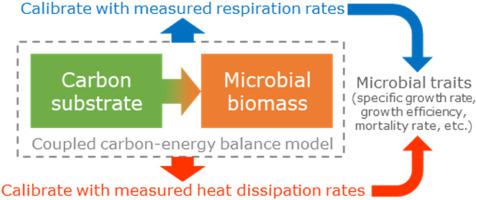Soil Biology and Biochemistry ( IF 9.8 ) Pub Date : 2021-02-09 , DOI: 10.1016/j.soilbio.2021.108169 Arjun Chakrawal , Anke M. Herrmann , Stefano Manzoni

|
Heat dissipation from organic matter decomposition is a well-recognized proxy for microbial activity in soils, but only a few modeling studies have used heat signals to quantify microbial traits such as maximum substrate uptake rate, specific growth rate, mortality rate, and growth efficiency. In this contribution, a hierarchy of coupled mass-energy balance models is proposed to estimate microbial traits encoded in model parameters using heat dissipation and respiration data from glucose induced microbial activity. Moreover, the models are used to explain the observed variability in calorespirometric ratios (CR)—the ratio of heat dissipation to respiration rate. We parametrized four model variants using heat dissipation and respiration rates measured in an isothermal calorimeter during the lag-phase only or during the whole growth-phase. The four variants are referred to as: (i) complex physiological model, (ii) simplified physiological model, (iii) lag-phase model, and (iv) growth-phase model. Model parameters were determined using three combinations of data: A) only the heat dissipation rate, B) only the respiration rate, and C) both heat dissipation and respiration rates. We assumed that the ‘best’ parameter estimates were those obtained when using all the data (i.e., option C). All model variants were able to fit the observed heat dissipation and respiration rates. The parameters estimated using only heat dissipation data were similar to the ‘best’ estimates compared to using only respiration rate data, suggesting that the observed heat dissipation rate can be used to constrain microbial models and estimate microbial traits. However, the observed variability in CR was not well captured by some model variants such as the simplified physiological model, in contrast to the lag- and growth-phase model that predicted CR well. This suggests that CR can be used to scrutinize how well metabolic processes are represented in decomposition models.
中文翻译:

利用能量流定量土壤中的微生物特征
有机物分解产生的热量是土壤中微生物活动的公认代表,但只有少数模型研究使用热信号来量化微生物特征,例如最大底物吸收率,比生长率,死亡率和生长效率。在此贡献中,提出了一个耦合的质量-能量平衡模型的层次结构,以使用由葡萄糖引起的微生物活动的散热和呼吸数据估算模型参数中编码的微生物特征。此外,这些模型还用于解释所观察到的量热比(CR)(散热与呼吸速率之比)之间的差异。我们使用仅在滞后阶段或整个生长阶段在等温量热仪中测量的散热和呼吸速率来参数化四个模型变量。这四个变体称为:(i)复杂生理模型,(ii)简化生理模型,(iii)滞后阶段模型和(iv)生长阶段模型。使用三个数据组合确定模型参数:A)仅散热率,B)仅呼吸率,以及C)散热和呼吸率。我们假设“最佳”参数估计是使用所有数据时获得的(即选项C)。所有模型变体均能够符合观察到的散热和呼吸速率。与仅使用呼吸速率数据相比,仅使用散热数据估算的参数与“最佳”估算值相似,这表明所观察到的散热速率可用于约束微生物模型和估算微生物特性。然而,与滞后和生长期模型可以很好地预测CR相比,某些模型变量(例如简化的生理模型)不能很好地捕获观察到的CR变异性。这表明CR可用于检查分解模型中新陈代谢过程的表现程度。











































 京公网安备 11010802027423号
京公网安备 11010802027423号